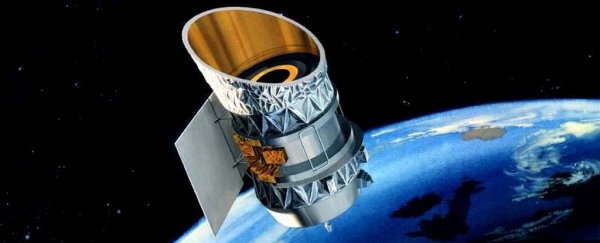There's a lot of stuff up there, whizzing around in low-Earth orbit. Given the thousands of old, defunct satellites that can no longer communicate with Earth, it's surprising how seldom they collide; but just such a collision might happen this week.
According to space debris tracking service LeoLabs, IRAS (a decommissioned space telescope launched in 1983) and GGSE-4 (a science payload aboard a decommissioned and only relatively recently declassified military satellite launched in 1967) are headed for a close encounter.
According to LeoLabs' data, on January 29, at 23:39:35 UTC, the two spacecraft will pass within just 15 to 30 metres (50 to 100 feet) of each other at an altitude of around 900 kilometres or 560 miles. And because both are dead as doornails, there's no way Earth can communicate with them to conduct evasive manoeuvres.
This means there's a one in 100 chance that they'll collide, according to LeoLabs' calculations.
1/ We are monitoring a close approach event involving IRAS (13777), the decommissioned space telescope launched in 1983, and GGSE-4 (2828), an experimental US payload launched in 1967.
— LeoLabs (@LeoLabs_Space) January 27, 2020
(IRAS image credit: NASA) pic.twitter.com/13RtuaOAHb
"Such collisions have happened in the past for sure. The thing that's really interesting about this one is that the estimated close pass within 15 to 30 metres is incredibly close," space archaeologist Alice Gorman of Flinders University told ScienceAlert.
"Spacecraft have taken evasive manoeuvres to avoid things that are only within 60 kilometres. So this is a really, really close encounter. And if this does actually come to pass, there's potentially a large amount of debris that will be created.
"I would say this is one of one of the most dangerous possible collisions that we've seen for some time."
The two spacecraft are no lightweights. IRAS had a launch mass of 1,083 kg (2,388 pounds) and occupies a space of 3.6 by 3.24 by 2.05 metres (11.8 by 10.6 by 6.7 feet).
GGSE-4, also known as Poppy 5 or 1967-053G, is much smaller, clocking in at just 85 kilograms (187 pounds), according to Harvard-Smithsonian astronomer Jonathan McDowell.
The NASA/NIVR IRAS satellite and the NRO/USN POPPY 5B satellite (aka GGSE 4) are predicted to make a close approach on Wednesday. POPPY 5B has 18-metre-long gravity gradient booms so a 15-to-30 metre predicted miss distance is alarming https://t.co/H1UckcoaAH
— Jonathan McDowell (@planet4589) January 27, 2020
And they're going fast. Their relative velocity is 14.7 kilometres per second (9.1 miles per second).
According to Gorman, if the two spacecraft collide, the smaller one will be obliterated, producing a cloud of new debris. The larger one would likely remain largely intact, but not without some damage, producing even more debris.
To be 100 percent clear, this poses absolutely no danger to us here on Earth. Any debris de-orbiting will burn up harmlessly on atmospheric re-entry. It won't even make it to the ground.
The concern, as we saw when India shot down a low-orbiting satellite last year, is about other spacecraft.
"They're going to be colliding at an incredibly high speed. And at that speed, it's going to probably cause the smaller satellite to break up completely into smaller fragments. And each of those fragments becomes a piece of space debris in its own right," Gorman explained.
"So you increase the number of pieces of space debris which increases the risk of colliding with a functioning satellite."
Of course, a collision may not happen - yet. But with more and more satellites reaching the end of their lives and being decommissioned, in addition to more and more satellites being sent up into low-Earth orbit, collisions are absolutely going to be a problem. It's very much a matter of when, not if.
The good news is that efforts are already underway to try and begin cleaning up the vast amount of trash we've left in space. The bad news, as demonstrated by this upcoming close encounter, is that we may be just a titch too late.
"The fear is, if we don't work out how to get rid of some of this debris in the next decade, these kinds of collisions will start to mean it's more difficult to launch satellites and carry out space operations," Gorman told ScienceAlert.
"So it's definitely a major concern."
LeoLabs will be continuing to monitor the two satellites, and update as the situation develops. You can follow them on Twitter to stay apprised.
Editor's note (29 January 2020): A previous version of this article stated an incorrect weight for GGSE-4. The mistake has now been rectified.
